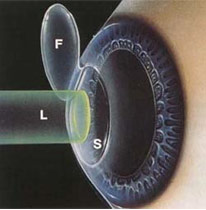LASIK works by using a laser beam to painlessly and precisely sculpt the cornea with a shape more accurate than that of glasses or contact lenses. Today LASIK, in its latest customized wavefront format, is a very mature technology in terms of both accuracy and safety, resting on the fact that more than 17 million cases of LASIK have been performed in the United States alone. PRK is a close cousin of LASIK in which no flap is made.
HOW LASIK WORKS
 The cornea is the main focusing structure of the eye. In people who wear glasses or contact lenses, the cornea has a flaw in its shape, causing blurry vision. The goal of LASIK is to precisely reshape the cornea using the laser beam to give it the correct shape. LASIK begins by gently lifting an ultra-thin surface layer of the cornea, which is carefully folded back to form a flap. The computer-controlled excimer laser is then applied beneath the flap, sculpting microscopic layers of the underlying cornea (with the total tissue removed usually being less than the thickness of a human hair). This laser is a “cold” laser, meaning it does not heat or damage underlying corneal tissue. Thanks to advanced computer guidance and tracking systems, the laser is accurate to one-billionth of an inch, even on a moving target. The shape that the most advanced form of LASIK sculpts into the cornea is more accurate than that of glasses or contact lenses.
The cornea is the main focusing structure of the eye. In people who wear glasses or contact lenses, the cornea has a flaw in its shape, causing blurry vision. The goal of LASIK is to precisely reshape the cornea using the laser beam to give it the correct shape. LASIK begins by gently lifting an ultra-thin surface layer of the cornea, which is carefully folded back to form a flap. The computer-controlled excimer laser is then applied beneath the flap, sculpting microscopic layers of the underlying cornea (with the total tissue removed usually being less than the thickness of a human hair). This laser is a “cold” laser, meaning it does not heat or damage underlying corneal tissue. Thanks to advanced computer guidance and tracking systems, the laser is accurate to one-billionth of an inch, even on a moving target. The shape that the most advanced form of LASIK sculpts into the cornea is more accurate than that of glasses or contact lenses.
WHAT IS IT LIKE TO UNDERGO LASIK?
LASIK is a remarkably quick procedure and surgery can be performed on both eyes on the same day. Before LASIK, you will undergo a comprehensive three-hour examination that includes a battery of tests. It is crucial to obtain the most precise data before surgery to provide the most accurate results postoperative, so Dr. Shapiro personally examines each patient and supervises all care. Dr. Shapiro is the only surgeon at the Shapiro Laser Eye Center and is personally committed to your best possible outcome. He will thoroughly examine you before and after surgery and will personally perform your surgery.
RECOVERY
 When you sit up after LASIK, no matter how poor your eyesight was before, you will immediately see a dramatic improvement. You will be given a sleeping pill and be asked to go home and get several hours of sleep, which speeds the recovery process. Some patients notice a scratchy feeling in their eyes for the first three to four hours after surgery, similar to the feeling of wearing dry contact lenses. By the day after the procedure, most patients have excellent vision and can comfortably drive a car and go back to work, all without glasses or contacts.
When you sit up after LASIK, no matter how poor your eyesight was before, you will immediately see a dramatic improvement. You will be given a sleeping pill and be asked to go home and get several hours of sleep, which speeds the recovery process. Some patients notice a scratchy feeling in their eyes for the first three to four hours after surgery, similar to the feeling of wearing dry contact lenses. By the day after the procedure, most patients have excellent vision and can comfortably drive a car and go back to work, all without glasses or contacts.
There are very few postoperative restrictions, but avoid water sports and any rubbing of the eye for one full month. You will be given protective eye shields to wear at night so you don’t inadvertently rub your eyes in your sleep. You can shower from the neck down the day after surgery, and then shower normally afterward, but with the eyes closed.
Although your vision typically will be quite good after surgery, it is normal to experience slight fluctuations in vision, as well as glare from headlights at night, for four to six weeks.
RISK
LASIK is a surgical procedure and, therefore, carries an element of risk. However, if LASIK is performed properly, the risk is low and most complications are treatable. A review of some of the risks associated with LASIK can be found on the FDA LASIK website:
ENHANCEMENT SURGERY
When LASIK is performed, the laser is set to give perfect correction. Unfortunately, no two people respond and heal exactly alike and, due to healing, a small percentage of patients may not achieve full correction of their vision. In this case, an enhancement procedure may be performed approximately six months later. This involves lifting the same corneal flap and applying the laser again to “custom-tailor” the result to the individual’s healing pattern. Recovery is similar to the initial procedure. Approximately two percent of patients benefit from an enhancement procedure, which is performed at no additional cost during the first three years following surgery.
